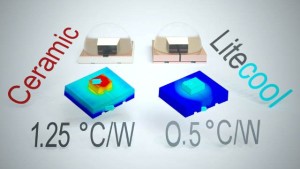Finding a way to deposit vertical dielectric barriers has allowed Litecool of Sheffield to make dramatic cut in LED thermal resistance – from 1.25 to 0.5°C/W is one case – see diagram.
Dielectric layers are essential to separate electrical conductors but, with a few notable exceptions like diamond, introduce thermal barriers.
Spreading heat before it reaches insulating layers with a thick thermal conductor like copper increases heat flow through subsequent insulating layers.
The concept, which is patent-pending, gets thick copper right up to the metal contacts on the LED package and is simple in concept, but stepping away from the 2D insulating layers usually seen in PCBs and reliably creating 3D dielectric structures is not so straight forward.
“It is not a difficult concept to design but it is difficult to manufacture. We have had to develop new manufacturing processes to allow for the track and gap ratios required, and it has resulted in performance way beyond anything else on the market,” said Litecool project engineer Robert Corbin.
For more detail: Sheffield firm slashes LED thermal resistance
